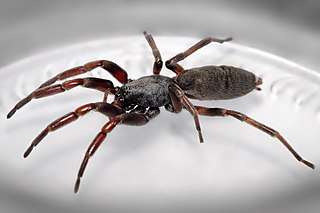
Ground spiders comprise Gnaphosidae, the seventh largest spider family with nearly 2,000 described species in over 100 genera distributed worldwide. There are 105 species known to central Europe, and common genera include Gnaphosa, Drassodes, Micaria, Cesonia, Zelotes and many others. They are closely related to Clubionidae. At present, no ground spiders are known to be seriously venomous to humans.

Gallieniellidae is a family of spiders first described by J. Millot in 1947. It was originally thought to be endemic to Madagascar until species were also found in southern Kenya, northeastern Argentina, and Australia. Drassodella was transferred from the family Gnaphosidae in 1990. They are suspected to be specialized in ant-preying.

Prodidominae is a spider subfamily, sometimes called long-spinneret ground spiders. It was formerly regarded as a separate family, Prodidomidae, which was reduced to a subfamily of the Gnaphosidae in 2018.

Lampona is a genus of South Pacific spiders in the family Lamponidae that was first described by Tamerlan Thorell in 1869. At least two species have a whitish tip to the abdomen and are known as "white-tailed spiders". Both hunt other spiders and have been introduced to New Zealand. The name is derived from the Middle English laumpe, meaning "light" or "fire".

Tamopsis is a genus of tree trunk spiders that was first described by B. Baehr & M. Baehr in 1987. Like other members of the family, they may be called two-tailed spiders, referring to two elongated spinnerets. The name is derived from the genus Tama and the Ancient Greek ὄψις (-opsis), meaning "resembling".

Asadipus is a genus of Australian white tailed spiders that was first described by Eugène Louis Simon in 1897. Originally placed with the Corinnidae, it was moved to the Lamponidae in 2000.
Lamponella is a genus of Australian white tailed spiders that was first described by Norman I. Platnick in 2000.
Notsodipus is a genus of Australian white tailed spiders that was first described by Norman I. Platnick in 2000.
Anzacia is a genus of South Pacific ground spiders that was first described by R. de Dalmas in 1919.
Eilica is a genus of ground spiders that was first described by Eugen von Keyserling in 1891.
Molycria is a genus of Australian ground spiders that was first described by Eugène Louis Simon in 1887.
Myandra is a genus of South Pacific ground spiders that was first described by Eugène Louis Simon in 1887.
Nomindra is a genus of Australian ground spiders that was first described by Norman I. Platnick & Barbara Baehr in 2006. Originally placed with the long-spinneret ground spiders, it was transferred to the ground spiders in 2018.
Prodidomus is a genus of ground spiders that was first described by Nicholas Marcellus Hentz in 1847.
Wesmaldra is a genus of Australian ground spiders that was first described by Norman I. Platnick & Barbara Baehr in 2006. Originally placed with the long-spinneret ground spiders, it was transferred to the ground spiders in 2018.
Wydundra is a genus of ground spiders that was first described by Norman I. Platnick & Barbara Baehr in 2006. Originally placed with the long-spinneret ground spiders, it was transferred to the ground spiders in 2018.
Storena is a genus of ant spiders first described by Charles Athanase Walckenaer in 1805.





